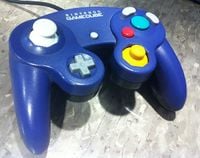Controller modification

A controller modification (commonly known as a controller mod) is a cosmetic or functional change to a stock controller.
Cosmetic mods focus on changing the physical appearance of the controller, such as by recoloring the casing or merging two different shells together to form a two-toned controller. Although rarer, other methods of cosmetic changes can also involve placing LEDs into the casing or changing the physical appearance of individual buttons.
Functional mods involve physically altering aspects of the controller, as to improve its function. Motives for modding controllers in these fashions include repairing an aging controller or creating a more customized experience by replacing individual components like buttons or analog sticks. While most players generally replace components with those from identical models, combining pieces from different controllers is not an uncommon practice, and those from non-Nintendo controllers, such as DualShock controllers, can be featured. Another category of mods include removing components, such as cutting springs or severing the rumble motor to either reduce weight, improve tactile functionality, or remove features the user finds undesirable. On the most extreme end of the spectrum, players will essentially design entirely different controllers from the ground up to meet very specific needs, either to make a design optimized for a certain game and playstyle or to overcome restrictions caused by physical disabilities.
While it is entirely feasible for someone to modify a controller themselves at home, doing so is typically not recommended to inexperienced users, especially with more complex modifications, due to the risks of damaging the controller. There is a market of professional modders that will modify on demand a user's controller for a monetary compensation. Certain modders also sell premade modified controllers online.
Common modifications[edit]
Cosmetic[edit]
- Swapping part or all of the shell with one of a different color/design
- Painting the shell
- Recolored buttons
- Engravements/embossments
- Installing internal lights
- Tactile or "clicky" buttons
Functional[edit]
- Fixed/mitigated manufacturing errors
- Control stick/C stick notches (best angles for Sweetspots, Fire Fox, wavedashing, Shield dropping, and drifting.)
- Removed or cut trigger springs
- Trigger plugs
- Recessed buttons/perforated pads
- Replacement of parts with equivalent parts from a different brand/kind of controller
- Rumble motor removal
- Snapback reduction
- Improved button tactility
- Adapters to use a controller on an otherwise incompatible system
- Design overhauls for accessibility purposes
- Add-ons for accessibility purposes
- Latency improvements
- Wireless firmware improvements
- Motherboard swaps to Phobs
- Z-jump
- Hall effect sensors
In competitive play[edit]
Modified controllers have been a part of the scene since its inception, but they particularly took off following the release of Super Smash Bros. Ultimate, due to growing frustrations of commercially available controllers often having specific design perks and flaws that are not present in other controllers and vice versa. Fans savvy in mechanical engineering and carpentry eventually decided to come together and develop "perfect" controllers that would have all the benefits of the best controllers while eschewing as many drawbacks as possible. The varying interpretations of "perfect" among fans has led to many different controller designs over the years, including models that excel at specific actions as opposed to the jack of all trades store bought controllers, and models designed to overcome motor function restrictions caused by permanent injuries and physical disabilities. Major corporations have also gotten into the business of hyper-specific controllers, using their resources to make high-quality versions of what fans were already making. This has all led to a steady increase in modded representation at tournaments that has opened the door for those otherwise unable or unwilling to play, overall increasing the diversity of Smash players.
In 2022, two new custom motherboards designed to replace standard stock motherboards for use in competitive play would release, Phob and Goomwaves. The use of these custom motherboards running custom software would receive high popularity in the community, convincing many top competitors to replace their stock GameCube controllers, though Goomwaves would fall out of favor due to being closed source and some dishonest practices. Phobs functionally acting as a perfect GameCube controller with features such as magnetic Hall effect sensors, digital snapback filtration, and notch calibration.
Legality[edit]
In general, modifications are tournament-legal as long as said modifications do not perform actions that could not feasibly be done by an average human or perform actions that "break the rules" of the game. For example, Fire Fox notches are legal, whereas an autofire function or the same action mapped to multiple buttons would not be. However, there is no unanimously accepted list of legal mods, so legality is on a case-by-case basis depending on the tournament organizer.
With the rise in popularity of controller modifications, arcade controllers, and phobs, a unified Melee Controller Ruleset would be proposed in 2024 by the Controller Ruleset Team with the aim of establishing regulations to reign in these alternative controllers and be more in-line to with stock controllers. The proposal received wide adoption within the community.
See also[edit]
External links[edit]
| Controllers and buttons | |
|---|---|
| Nintendo 64 controller | |
| Nintendo GameCube controller | |
| Wii Remote (and Nunchuk) | |
| Classic Controller | L |
| Nintendo 3DS | |
| Wii U GamePad / Wii U Pro Controller | L |
| Joy-Con / Joy-Con 2 | |
| Nintendo Switch Pro Controller / Nintendo Switch 2 Pro Controller | L |
| Third-party controllers | Hori Mini Pad · Arcade controller · Keyboard |
| Other | Smash Controller · Controller modification |